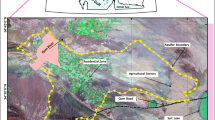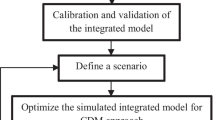Abstract
Groundwater is the main water resource in many semi-arid coastal regions and water demand, especially in summer months, can be very high. Groundwater withdrawal for meeting this demand often causes seawater intrusion and degradation of water quality of coastal aquifers. In order to satisfy demand, a combined management plan is proposed and is under consideration for the island of Santorini. The plan involves: (1) desalinization (if needed) of pumped water to a potable level using reverse osmosis and (2) injection into the aquifer of biologically-treated waste water. The management plan is formulated in a multi-objective, optimization framework, where simultaneous minimization of economic and environmental costs is desired, subject to a constraint so that cleaned water satisfies demand. The decision variables concern the well locations and the corresponding pumping and recharging rates. The problem is solved using a computationally efficient, multi-objective, genetic algorithm (NSGAII). The constrained multi-objective, optimization problem is transformed to an unconstrained one using a penalty function proportional to constraint violation. This extends the definition of the objective function outside the domain of feasibility. The impact of prolonged droughts on coastal aquifers is investigated by assuming various scenarios of reduced groundwater recharge. Water flow and quality in the coastal aquifer is simulated using a three-dimensional, variable density, finite difference model (SEAWAT). The method is initially applied to a test aquifer and the trade-off curves (Pareto fronts) are determinedl for each drought scenario. The trade-off curves indicate an increase on the economic and environmental cost as groundwater recharge reduces due to climate change.
Similar content being viewed by others
References
Abbo H, Gev I (2008) Numerical model as a predictive analysis tool for rehabilitation and conservation of the Israeli coastal aquifer: example of the SHAFDAN sewage reclamation project. Desalination 226(1–3):47–55. doi:10.1016/j.desal.2007.01.233
Cheremisinoff N (2002) An overview of water and waste-water treatment, handbook of water and wastewater treatment technologies. Butterworth-Heinemann, Woburn, pp 1–61. doi:10.1016/B978-075067498-0/50004-8. ISBN 978-0-75-067498-0
Das A, Datta B (1999) Development of management models for sustainable use of coastal aquifers. J Irrig Drain Eng 127(3):112–121
Deb K, Pratap A, Agarwal S, Meyarivan T (2002) A fast and elitist multi-objective genetic algorithm: NSGA-Ii. IEEE Trans Evol Comput 6:182–197
Georgopoulou E, Kotronarou A, Koussis A, Restrepo PJ, Gomez-Gotor A, Jimenez JJR (2001) A methodology to investigate brackish groundwater desalination coupled with aquifer recharge by treated wastewater as an alternative strategy for water supply in Mediterranean areas. Desalination 136:307–315
Guo W, Langevin CD (2002) User’s guide to SEAWAT: a computer program for simulation of three-dimensional variable-density groundwater flow. Tech. Rep., US Geol. Surv. Open File, 01-434
Karterakis SM, Karatzas GP, Papadopoulou IKNMP (2007) Application of linear programming and differential evolutionary optimization methodologies for the solution of coastal subsurface water management problems subject to environmental criteria. J Hydrol 342:270–282
Kourakos G, Mantoglou A (2009) Pumping optimization of coastal aquifers based on evolutionary algorithms and surrogate modular neural network models. Adv Water Resour 32(4):507–521
Li Q, Harris B, Aydogan C, Ang M, Tade M (2006) Feasibility of recharging reclaimed wastewater to the coastal aquifers of Perth, Western Australia. Process Saf Environ Prot 84(4):237–246
Lopez A, Vurro M (2008) Planning agricultural wastewater reuse in Southern Italy: the case of Apulia region. Desalination 218:164–169
Mantoglou A (2003) Pumping management of coastal aquifers using analytical models of seawater intrusion. Water Resour Res 39(12):891–1335. doi:10.1029/2002WR001
Mantoglou A, Papantoniou M (2008) Optimal design of pumping networks in coastal aquifers using sharp interface models. J Hydrol 361:52–63
Mantoglou A, Papantoniou M, Giannoulopoulos P (2004) Management of coastal aquifers based on nonlinear optimization and evolutionary algorithms. J Hydrol 297:209–228
Park CH, Aral MM (2004) Multi-objective optimization of pumping rates and well placement in coastal aquifers. J Hydrol 290:80–99. doi:10.1016/j.jhydrol.2003.11.025
Prieto C, Kotronarou A, Destouni G (2006) The influence of temporal hydrological randomness on seawater intrusion in coastal aquifers. J Hydrol 330:285–300. doi:10.1016/j.jhydrol.2006.03.024
Rao S, Thandaveswara B, Sudheer K (2004) Planning groundwater development in coastal aquifers. Hydrol Sci 49(1):155–170
Author information
Authors and Affiliations
Corresponding author
Rights and permissions
About this article
Cite this article
Kourakos, G., Mantoglou, A. Simulation and Multi-Objective Management of Coastal Aquifers in Semi-Arid Regions. Water Resour Manage 25, 1063–1074 (2011). https://doi.org/10.1007/s11269-010-9677-x
Received:
Accepted:
Published:
Issue Date:
DOI: https://doi.org/10.1007/s11269-010-9677-x




